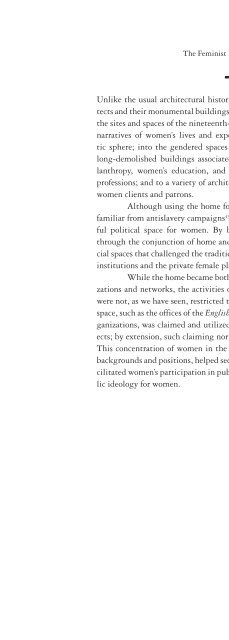The Unknown City: Contesting Architecture and Social Space
The Unknown City: Contesting Architecture and Social Space The Unknown City: Contesting Architecture and Social Space
The Feminist Remapping of Space in Victorian London ■ Unlike the usual architectural history of London, which focuses on architects and their monumental buildings, an approach that retraces and remaps the sites and spaces of the nineteenth-century women’s movement prompts narratives of women’s lives and experience. It takes us into the domestic sphere; into the gendered spaces of Victorian architecture; to sites of long-demolished buildings associated with the suffrage movement, philanthropy, women’s education, and entry into and employment in the professions; and to a variety of architectural and social projects devised by women clients and patrons. Although using the home for political ends was not new—it was familiar from antislavery campaigns 43 —the politicized home was a powerful political space for women. By blending public and private spheres through the conjunction of home and work, these women created new social spaces that challenged the traditional division between the public male institutions and the private female place of home. While the home became both center and origin of women’s organizations and networks, the activities of these nineteenth-century feminists were not, as we have seen, restricted to domestic space or identities. Public space, such as the offices of the English Woman’s Journal and its associated organizations, was claimed and utilized to promote feminist goals and projects; by extension, such claiming normalized women’s presence in the city. This concentration of women in the city, combined with their privileged backgrounds and positions, helped secure access to the public sphere and facilitated women’s participation in public life and the development of a public ideology for women.
- Page 618: In Amsterdam in 1990, I dwelled for
- Page 622: The Contested Streetscape in Amster
- Page 626: 16.2 | Spuistraat, Amsterdam, 1995.
- Page 630: The Contested Streetscape in Amster
- Page 634: The Contested Streetscape in Amster
- Page 638: The Contested Streetscape in Amster
- Page 642: The Contested Streetscape in Amster
- Page 646: This page intentionally left blank
- Page 650: The West End of Victorian London is
- Page 654: The Feminist Remapping of Space in
- Page 658: The Feminist Remapping of Space in
- Page 662: The Feminist Remapping of Space in
- Page 666: 17.2 | The Pioneer Club, Cork Stree
- Page 672: Part 2: Filtering Tactics 308 17 30
- Page 676: Part 2: Filtering Tactics 310 17 31
- Page 680: Part III Tactics
- Page 684: Nigel Coates 18 Brief Encounters a
- Page 688: Part III: Tactics 316 18 317 Nigel
- Page 692: Part III: Tactics 318 18 319 Nigel
- Page 696: Nigel Coates 18.4 | Sana, Yemen. 18
- Page 700: Part III: Tactics 322 18 323 Nigel
- Page 704: Part III: Tactics 324 18 325 Nigel
- Page 708: Part III: Tactics 326 18 327 Nigel
- Page 712: Cornford & Cross The power of a wor
- Page 716: Part III: Tactics 330 19 331 Cornfo
<strong>The</strong> Feminist Remapping of <strong>Space</strong> in Victorian London<br />
■<br />
Unlike the usual architectural history of London, which focuses on architects<br />
<strong>and</strong> their monumental buildings, an approach that retraces <strong>and</strong> remaps<br />
the sites <strong>and</strong> spaces of the nineteenth-century women’s movement prompts<br />
narratives of women’s lives <strong>and</strong> experience. It takes us into the domestic<br />
sphere; into the gendered spaces of Victorian architecture; to sites of<br />
long-demolished buildings associated with the suffrage movement, philanthropy,<br />
women’s education, <strong>and</strong> entry into <strong>and</strong> employment in the<br />
professions; <strong>and</strong> to a variety of architectural <strong>and</strong> social projects devised by<br />
women clients <strong>and</strong> patrons.<br />
Although using the home for political ends was not new—it was<br />
familiar from antislavery campaigns 43 —the politicized home was a powerful<br />
political space for women. By blending public <strong>and</strong> private spheres<br />
through the conjunction of home <strong>and</strong> work, these women created new social<br />
spaces that challenged the traditional division between the public male<br />
institutions <strong>and</strong> the private female place of home.<br />
While the home became both center <strong>and</strong> origin of women’s organizations<br />
<strong>and</strong> networks, the activities of these nineteenth-century feminists<br />
were not, as we have seen, restricted to domestic space or identities. Public<br />
space, such as the offices of the English Woman’s Journal <strong>and</strong> its associated organizations,<br />
was claimed <strong>and</strong> utilized to promote feminist goals <strong>and</strong> projects;<br />
by extension, such claiming normalized women’s presence in the city.<br />
This concentration of women in the city, combined with their privileged<br />
backgrounds <strong>and</strong> positions, helped secure access to the public sphere <strong>and</strong> facilitated<br />
women’s participation in public life <strong>and</strong> the development of a public<br />
ideology for women.



